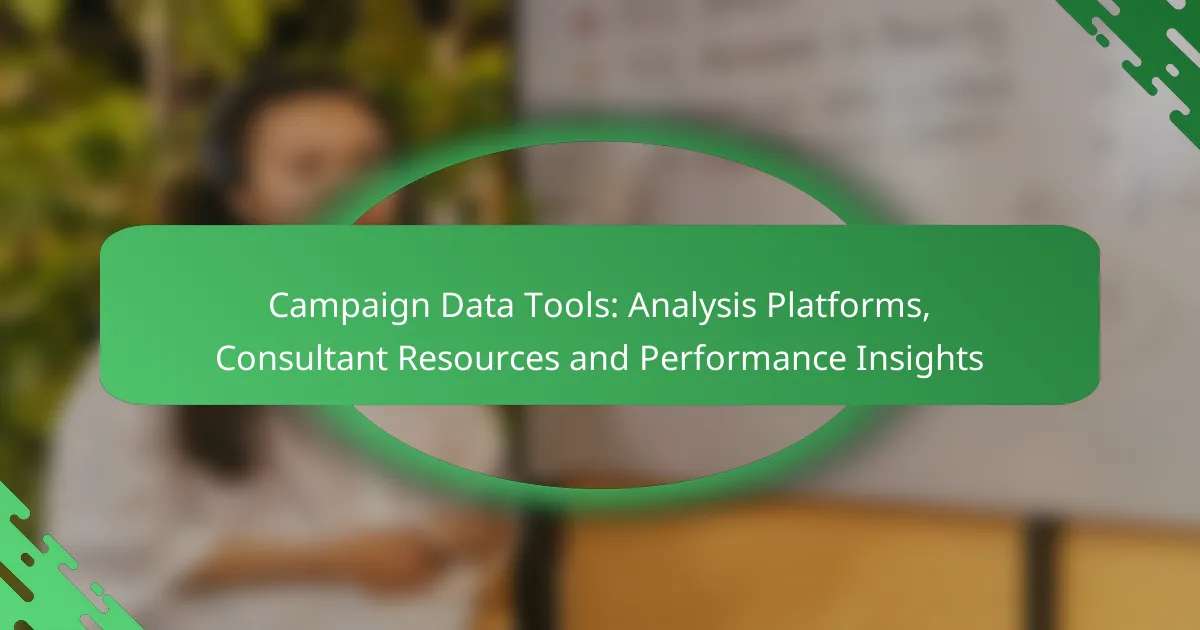Campaign data tools are essential for marketers seeking to optimize their strategies through insightful analysis. These platforms offer real-time performance tracking, customizable dashboards, and advanced reporting capabilities, enabling users to make informed decisions based on actionable analytics. Selecting the right tool requires careful consideration of your specific needs, campaign goals, and integration capabilities.

What are the best campaign data analysis tools in the US?
The best campaign data analysis tools in the US provide marketers with essential insights to optimize their strategies. These platforms help track performance metrics, visualize data, and improve decision-making through actionable analytics.
Google Analytics
Google Analytics is a widely used tool that offers in-depth insights into website traffic and user behavior. It allows marketers to track key performance indicators (KPIs) such as page views, bounce rates, and conversion rates, making it essential for campaign analysis.
To get started, set up tracking codes on your website and define goals that align with your campaign objectives. Regularly review reports to identify trends and areas for improvement, ensuring your marketing efforts are data-driven.
Tableau
Tableau is a powerful data visualization tool that helps marketers create interactive dashboards and reports. It can integrate with various data sources, allowing users to analyze campaign performance across multiple channels.
Consider using Tableau for its ability to present complex data in an easily digestible format. When using Tableau, focus on creating visualizations that highlight key metrics, enabling quick insights and informed decision-making.
Adobe Analytics
Adobe Analytics provides comprehensive analytics solutions tailored for enterprise-level businesses. It offers advanced segmentation, real-time data processing, and predictive analytics, making it suitable for large-scale campaigns.
Utilize Adobe Analytics to gain deeper insights into customer journeys and behavior. Ensure you leverage its robust reporting features to track campaign performance and optimize your marketing strategies effectively.
HubSpot
HubSpot is an all-in-one marketing platform that includes campaign analytics as part of its suite. It allows users to track leads, conversions, and customer interactions, providing a holistic view of campaign effectiveness.
To maximize HubSpot’s capabilities, integrate it with your existing tools and regularly analyze the performance of your marketing assets. Use its reporting features to adjust your campaigns based on real-time data.
Mixpanel
Mixpanel focuses on product and user analytics, making it ideal for tech-driven campaigns. It tracks user interactions and behaviors, allowing marketers to understand how users engage with their products over time.
Implement Mixpanel to analyze user retention and conversion rates. Use its funnel analysis feature to identify drop-off points in your campaigns, helping you refine your strategies for better results.

How to choose the right campaign data tool?
Selecting the right campaign data tool involves understanding your specific needs and how different platforms can meet those requirements. Focus on your campaign goals, integration capabilities, user experience, and pricing models to make an informed decision.
Define campaign goals
Clearly defining your campaign goals is crucial in choosing a data tool that aligns with your objectives. Whether you aim to increase brand awareness, drive sales, or enhance customer engagement, your tool should support these specific targets.
For example, if your goal is to boost sales, look for tools that offer robust analytics and reporting features to track conversion rates and customer behavior. Ensure the tool can provide insights that directly relate to your defined goals.
Evaluate integration capabilities
Integration capabilities are essential for ensuring that your campaign data tool works seamlessly with other systems you use, such as CRM software or email marketing platforms. A tool that easily integrates can streamline your workflow and enhance data accuracy.
Check if the tool supports APIs or has pre-built connectors for popular platforms. This can save time and reduce the risk of data silos, allowing for a more comprehensive view of your campaign performance.
Consider user experience
User experience plays a significant role in how effectively your team can utilize the campaign data tool. A user-friendly interface can facilitate quicker adoption and reduce the learning curve for team members.
Look for tools that offer intuitive dashboards, customizable reports, and easy navigation. Consider requesting demos or trial periods to assess how well the tool meets your team’s needs before making a commitment.
Assess pricing models
Understanding the pricing models of different campaign data tools is vital to ensure they fit within your budget. Pricing can vary widely based on features, user limits, and subscription tiers.
Some tools may offer tiered pricing based on usage, while others may charge a flat rate. Evaluate what features are included at each price point and consider any additional costs for integrations or advanced functionalities to avoid unexpected expenses.

What are the key features of effective analysis platforms?
Effective analysis platforms are characterized by their ability to process data in real-time, provide customizable dashboards, offer advanced reporting capabilities, and include robust data visualization tools. These features enable users to gain actionable insights and make informed decisions quickly.
Real-time data processing
Real-time data processing allows analysis platforms to capture and analyze data as it is generated. This feature is crucial for organizations that need to respond swiftly to changing conditions, such as market trends or customer behaviors. Look for platforms that can handle high-velocity data streams with minimal latency.
Consider platforms that support event-driven architectures, which can process data in milliseconds. This capability is particularly beneficial for industries like finance or e-commerce, where timely insights can significantly impact performance.
Customizable dashboards
Customizable dashboards enable users to tailor their data views according to specific needs and preferences. This flexibility helps stakeholders focus on the most relevant metrics and KPIs for their roles. Choose platforms that offer drag-and-drop functionality for easy dashboard creation.
Additionally, look for options that allow for widget integration, enabling users to display various data types, such as charts, tables, and gauges. This personalization enhances user engagement and improves decision-making processes.
Advanced reporting capabilities
Advanced reporting capabilities are essential for generating comprehensive insights from data. Effective analysis platforms should offer automated report generation, allowing users to schedule reports and receive them via email or other channels. This saves time and ensures stakeholders have access to the latest information.
Consider platforms that support multiple report formats, such as PDF, Excel, or interactive web reports. This versatility ensures that reports can be easily shared and understood by diverse audiences, from technical teams to executive management.
Data visualization tools
Data visualization tools transform complex data sets into easily digestible visual formats, making it simpler to identify trends and patterns. Effective analysis platforms should include a variety of visualization options, such as charts, graphs, and heat maps, to cater to different analytical needs.
When selecting a platform, prioritize those that offer interactive visualizations, enabling users to drill down into data for deeper insights. This interactivity can enhance presentations and facilitate better discussions among team members and stakeholders.

What are the top consultant resources for campaign data?
The top consultant resources for campaign data include marketing analytics consultants, data strategy agencies, and freelance data analysts. These professionals help organizations optimize their data usage for more effective campaign strategies and performance insights.
Marketing analytics consultants
Marketing analytics consultants specialize in analyzing data to improve marketing performance. They typically assess campaign metrics, customer behavior, and market trends to provide actionable insights. When selecting a consultant, consider their experience with your industry and the specific tools they use.
Common services offered by these consultants include performance tracking, ROI analysis, and predictive modeling. They often utilize platforms like Google Analytics, Tableau, or Adobe Analytics to gather and interpret data.
Data strategy agencies
Data strategy agencies focus on developing comprehensive data plans that align with business objectives. They help organizations identify key performance indicators (KPIs) and establish frameworks for data collection and analysis. A well-defined data strategy can enhance decision-making and drive campaign success.
When engaging a data strategy agency, evaluate their approach to data governance and compliance with regulations such as GDPR or CCPA. Look for agencies that offer tailored solutions and have a track record of successful implementations.
Freelance data analysts
Freelance data analysts provide flexible and often cost-effective solutions for analyzing campaign data. They can work on specific projects or provide ongoing support, making them a versatile option for businesses of all sizes. Hiring a freelancer allows for greater control over budget and project scope.
When hiring a freelance analyst, review their portfolio and client testimonials to ensure they have relevant experience. Platforms like Upwork or Fiverr can be useful for finding qualified candidates, but always conduct thorough interviews to assess their skills and fit for your needs.

How to interpret performance insights from campaign data?
Interpreting performance insights from campaign data involves understanding the metrics that reflect your campaign’s effectiveness. By analyzing these insights, you can identify strengths and weaknesses, enabling informed decisions for future strategies.
Identify key performance indicators
Key performance indicators (KPIs) are essential metrics that help gauge the success of your campaign. Common KPIs include conversion rates, click-through rates, and return on investment (ROI). Focus on a few critical KPIs that align with your campaign goals to streamline analysis.
For example, if your campaign is aimed at increasing website traffic, monitor metrics like unique visitors and page views. Establishing clear KPIs allows for more focused performance evaluation and actionable insights.
Analyze trends over time
Analyzing trends over time helps you understand how your campaign’s performance evolves. Look for patterns in your data, such as seasonal fluctuations or changes in audience engagement. This longitudinal analysis can reveal what strategies are working and which need adjustment.
For instance, if you notice a consistent increase in engagement during specific months, consider ramping up your efforts during those periods. Regularly reviewing trends can inform future campaign planning and resource allocation.
Compare against benchmarks
Comparing your campaign performance against industry benchmarks provides context for your results. Benchmarks can be derived from historical data or industry standards, giving you a reference point to assess your success. This comparison can highlight areas for improvement or validate effective strategies.
For example, if your average conversion rate is 3% and the industry benchmark is 5%, this indicates a need for optimization. Utilize available resources, such as industry reports or analytics tools, to gather relevant benchmarks for a more accurate evaluation.
